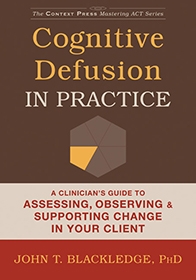 Counseling is as much an art as it is a science. Effective practitioners continuously evaluate their approach to providing ethical and efficacious mental health care. Moreover, effectual practitioners keep abreast of current trends and promising evidenced-based practices to inform their own approach to working with clients. After reviewing this volume, it became clear to me that the author is motivated to continuously improve his work with clients in the tradition of the wise artisan. In this book, John T. Blackledge adds to the literature by sharing his expertise with a useful and accessible clinician’s guide that incorporates cognitive defusion, a way of thinking about thoughts in acceptance and commitment therapy (ACT), into mindfulness-based therapies, as well as a variety of other types of counseling. The chapters are arranged in a thoughtful fashion such that cognitive defusion is defined in chapter 1, and in chapters 1 through 4, the author describes the usefulness of cognitive defusion for different contexts. In chapters 5 through 10, the author provides a detailed description of how to incorporate cognitive defusion in therapy sessions with clients.
Counseling is as much an art as it is a science. Effective practitioners continuously evaluate their approach to providing ethical and efficacious mental health care. Moreover, effectual practitioners keep abreast of current trends and promising evidenced-based practices to inform their own approach to working with clients. After reviewing this volume, it became clear to me that the author is motivated to continuously improve his work with clients in the tradition of the wise artisan. In this book, John T. Blackledge adds to the literature by sharing his expertise with a useful and accessible clinician’s guide that incorporates cognitive defusion, a way of thinking about thoughts in acceptance and commitment therapy (ACT), into mindfulness-based therapies, as well as a variety of other types of counseling. The chapters are arranged in a thoughtful fashion such that cognitive defusion is defined in chapter 1, and in chapters 1 through 4, the author describes the usefulness of cognitive defusion for different contexts. In chapters 5 through 10, the author provides a detailed description of how to incorporate cognitive defusion in therapy sessions with clients.
The book has many strengths. For example, in Chapter 1 the author describes the history of cognitive defusion and situates the construct in terms of its Buddhist origin. In addition, he describes cognitive defusion’s usefulness in mindfulness-based therapies. Dr. Blackledge also discusses how thoughts can have tremendous influence over a client’s feeling state, with the client’s emotions being fused to those thoughts. The author then introduces techniques that are designed to defuse the client’s emotions from the thoughts, which ultimately lessens client emotional discomfort and leads to positive and measurable therapeutic change.
The author’s central premise—that thoughts in the form of words may not be able to capture the richness of in-the-moment experience—may liberate clients struggling with irrational thinking or cognitive distortions such as negative self-evaluations. The author states that thoughts are not necessarily holistically accurate. One cognitive defusion technique the author describes is teaching the client to conduct a nonjudgmental review of the negative self-talk, as a bystander, which allows the client to defuse from these negative self-evaluations, lessening emotional distress. The author discusses the similarities and differences between these cognitive constructs and techniques and those of Cognitive Behavioral Therapy (CBT). Specifically, CBT posits that thinking changes emotions (i.e., cognitive restructuring), whereas cognitive defusion posits that words and thoughts do not necessarily hold power over emotional change. The author discusses the movement in metacognitive therapy, which emphasizes thinking about and relating to thoughts in different ways. He points out that the change element in metacognitive therapy is for the client to learn to tolerate or sit with problematic thoughts, a construct well researched in dialectical behavior therapy. Another strength of this text is that the author includes many therapist–client dialogues, in the form of transcripts, to allow the reader to see how the author introduces and incorporates the various techniques into therapy sessions with clients.
In addition to its strengths, the book has a couple of limitations. The author provides an excellent review of the literature regarding empirical support for cognitive defusion as a therapeutic technique. I would have preferred this section be introduced earlier in the book, perhaps after the first two chapters. Scholars tend to want to critically review the research and support for the proposed model of therapy prior to delving into the suggested method of applying the model (i.e., the clinician’s guide portion). Additionally, a graphical representation of the different views of thinking in the various therapeutic models (e.g., CBT, ACT) would have facilitated an easier comparison of the important differences.
The author has provided a helpful guide for clinicians at all levels of expertise to learn about and integrate cognitive defusion techniques into their therapeutic practice. Experts have predicted movement toward mindfulness-based therapies in the 21st century, which makes this text a particularly timely and valuable contribution. I recommend this clinician’s guide for any therapist or counselor interested in mindfulness-based counseling.
Blackledge, J. T. (2015). Cognitive defusion in practice: A clinician’s guide to assessing, observing, & supporting change in your client. Oakland, CA: New Harbinger.
Reviewed by: Donald “Rick” Froyd, Jr., NCC, University of Phoenix, Tempe, AZ.
The Professional Counselor
